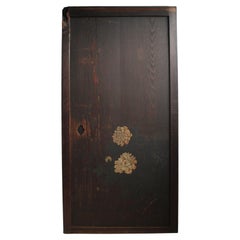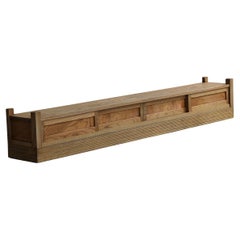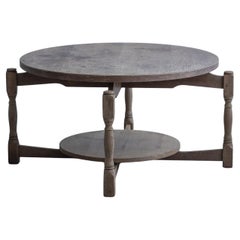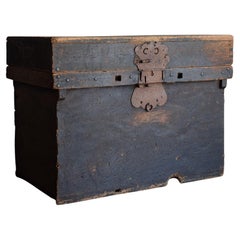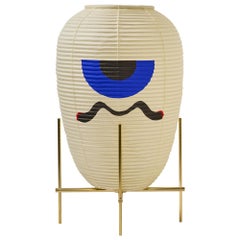Japanese Antiquities
to
82
131
41
381
13
2
3
2
1
29
118
234
15
111
26
60
4
2
4
2
1
3
5
5
15
2
178
101
75
48
47
1,902
1,343
739
396
388
396
393
393
10
1
1
Place of Origin: Japanese
D2 Japanese Antiques Board painting, sliding door, fittings, Peony & Bamboo
Located in Niiza, JP
Size: Depth *3cm Width *87cm Height *173cm 8kg
Estimated packing size: (Sandwich with 5-10mm plywood)
12 × 100 × 185cm 35kg
This is an old fittings of ita-e (wooden board painting...
Category
19th Century Antique Japanese Antiquities
Materials
Cedar
Japanese Antique Cabinets , Low board Storage , Wabi Sabi, Japandi
Located in Katori-Shi, 12
This is an antique lowboard made in Japan. In Japan, it was used as a flooring.
A flooring is a platform that can be moved, like the floorboards of a tokonoma, which is indispensabl...
Category
Early 20th Century Taisho Japanese Antiquities
Materials
Wood
Japanese Antique Living Low Table, Wabi Sabi
Located in Katori-Shi, 12
A tasteful round low table made of oak.
It is an item from the early Showa period.
The tabletop has a firm texture and becomes more tasteful with age, giving it a deep and warm look...
Category
Early 20th Century Showa Japanese Antiquities
Materials
Wood
Japanese Antique Black Wooden Box 1860s-1900s/Sofa Table Tansu Mingei Storage
Located in Sammu-shi, Chiba
This is an old Japanese black wooden box. It is from the Meiji period (1860s-1900s). The material is cedar. This is black and beautiful. Afte...
Category
Late 19th Century Meiji Antique Japanese Antiquities
Materials
Wood
$900 Sale Price
25% Off
GOOD MELLOW LIMITED05, Japanese Antique side table, Wabi Sabi, Japandi
Located in Katori-Shi, 12
This series is based on the extremely popular antique coffee table that is hard to find and sells out quickly when it arrives.
The ash wood is finished with an oil coating.
This tab...
Category
2010s Taisho Japanese Antiquities
Materials
Wood
Contemporary Japanese Chochin Floor Lamp Limited Edition #2 Zen Washi
By Ryosuke Harashima
Located in Shibuya-ku, Tokyo
Name: OBAKE UN
Contemporary style Japanese Washi Japanese traditional paper shade floor lamp. Washi shade is famous as Isamu Noguchi Akari lightings.
Base is made of brass. Limited pattern painted model. Edition of 3+1AP
E26,27 light bulb.
Available to work with 100-250V.
Artist statement
In Japan, there is an animist belief that the soul dwells in old tools that have passed a long time and turns into spirits such as "Youkai" or "OBAKE." Its existence lurks in the darkness of everyday life, sometimes causing fear and sometimes entertaining.
This lantern is not an old tool, but it is made by the historic "Kojima Shoten", where the 10th generation are craftsmen in Kyoto. It's rare nowadays, and it's a style in which lanterns are made from bamboo bones to assembling papers and painting in one workshop and go. So, I decided to transform the polite crafted Japanese lanterns, which have been run through a traditional history, into a modern and pop style. It's not just OBAKE lurking in the darkness, but an existence who snuggles up to us as a more sophisticated being.
These one-eyed OBAKE have a meaningful look that originated in ancient Sanskrit culture. The red-eye "A [a]" is the facial expression that is the first pronunciation to make a sound in Sanskrit, which means "truth" and "spirit of inquiry" at the same time. The blue-eyed "UN [hu?]" expresses the pronunciation to close the sound, and at the same time means "wisdom" and "nirvana." There is also the idea that describing the beginning and end of the universe is represented by considering the "A" and "UN" as a pair. In Asia, it is a common sight to see a pair of guardian statues...
Category
2010s Edo Japanese Antiquities
Materials
Brass
Japanese Wall Art / Japanese objet / wabi-sabi art / primitive wall art
Located in Sammu-shi, Chiba
This is a wall art made using some of the material from an old Japanese door.
This is a wooden door reinforced with galvanized iron sheets.
It's a convenient size that doesn't take...
Category
2010s Primitive Japanese Antiquities
Materials
Tin
Rare Early Japanese Hibachi with Unique Makie Lacquer Scene, 19th, planter
Located in Fukuoka, JP
An exceptional and rare example of an early Japanese hibachi (charcoal brazier), this elegant piece is crafted from kiri wood (paulownia) and fitted with a beautifully aged copper in...
Category
19th Century Meiji Antique Japanese Antiquities
Materials
Copper
Japanese Antique Cabinets, Wabi Sabi, Japandi
Located in Katori-Shi, 12
This is an antique Japanese-style cabinet made in the Meiji period.
The texture of the black lacquer, smoked with soot from the hearth, has a unique depth and charm that is unlike a...
Category
Early 20th Century Meiji Japanese Antiquities
Materials
Wood
Japanese silk jacket HAORI dark purple with white butterfly pattern
Located in Paris, FR
This is a silk jacket which was made in Japan.
It was made in Showa era around 1980s.
The haori is a traditional Japanese hip- or thigh-length jacket worn over a kimono. Resembling ...
Category
Late 20th Century Showa Japanese Antiquities
Materials
Silk
Antique Japanese "Wagasa" Umbrella, 20th Century
Located in Edogawa-ku Tokyo, JP
This handcrafted traditional Japanese umbrella, made of bamboo and washi paper, carries the quiet beauty of age and imperfection.
Its weathered texture and graceful form bring a sens...
Category
Early 20th Century Japanese Antiquities
Materials
Bamboo, Paper
Japanese Silk Jacket Michiyuki 1970s
Located in Paris, FR
This is a Japanese Silk Jacket called Michiyuki.
It was made around 1970s. This Michiyuki Jacket has a pocket and belts inside.
It is not reversi...
Category
1970s Showa Vintage Japanese Antiquities
Materials
Silk
Japanese Tansu, Wabi-sabi, 1920s, Japan
Located in Tokyo, Tokyo
The unique antique tansu — an elegant piece of furniture with deep Japanese roots.
This small tansu features six compartments that are not only functional but also serve as a work o...
Category
Early 20th Century Arts and Crafts Japanese Antiquities
Materials
Wood
Antique Japanese Sumida Gaia Pottery Pitcher with Elephants
Located in Palm Beach, FL
Lofty antique Japanese pottery pitcher hand crafted in the traditional Sumida Gawa technique having a drip glazed over hand formed elephants on a red background.
Category
Early 20th Century Anglo-Japanese Japanese Antiquities
Materials
Pottery
Japanese Kimono-Kasuri
Located in Paris, FR
In the 1980s, as Japan's economy flourished and daily life became more affluent, interest in traditional culture and folk crafts began to grow. Within this trend, Kasuri kimono—once common everyday wear or work clothes for ordinary people—started to be reevaluated.
Kasuri is a traditional Japanese...
Category
Late 20th Century Showa Japanese Antiquities
Materials
Silk
Early 20th Century, Showa, Japanese Bronze Vase
Located in Sampantawong, TH
Japanese bronze vase.
Age: Japan, Showa Period, Early 20th century
Size: Height 40.2 C.M. / Width 27.5 C.M.
Condition: Nice condition overall.
Category
Early 20th Century Japanese Antiquities
Materials
Bronze
$1,200 Sale Price
20% Off
19th C., Meiji, Antique Japanese Bronze Animal Rat / Mouse Holding A Chestnut
Located in Sampantawong, TH
Japanese bronze animal rat / mouse holding a chestnut with artist sign.
Artist signature is on the last photo.
Age: Japan, Meiji Period, 19th Century
Size: Length 14.4 C.M. / Width ...
Category
19th Century Antique Japanese Antiquities
Materials
Bronze
$1,480 Sale Price
20% Off
Old Japanese wooden wall hanging object/wooden mold/20th century
Located in Sammu-shi, Chiba
This is an old Japanese wooden mold, probably made in the 20th century during the Showa period. I don't know what it was used for, but it has a unique texture as a traditional tool u...
Category
20th Century Showa Japanese Antiquities
Materials
Wood
Contemporary Japanese Chochin Floor Lamp Zen Washi Japanese Paper Shade
By Ryosuke Harashima
Located in Shibuya-ku, Tokyo
Name: Under the Hazy Moon
Contemporary style Japanese Washi Japanese traditional paper shade floor lamp. Washi shade is famous as Isamu Noguchi Akari lightings.
Base is made of brass...
Category
2010s Edo Japanese Antiquities
Materials
Brass
$2,600 Sale Price / item
31% Off
Japanese Drawer Chest, Wabi-sabi, Japan
Located in Tokyo, Tokyo
A beautifully crafted antique tansu, piece of functional furniture with deep Japanese roots. This larger tansu features six compartments, making it both a practical storage solution...
Category
Mid-20th Century Japanese Antiquities
Materials
Wood
wabi sabi rustic Japanese wood sculpture, abstract Dai display stand, bonsai
Located in 常陸大宮市, JP
Thick old Keyaki (Japanese Zelkova) hardwood block
- Is a unique, wabi sabi art piece itself, also can be used as a display stand for, such as plants (Bonsai & succulent), decorative...
Category
20th Century Rustic Japanese Antiquities
Materials
Wood, Hardwood
Samuraï armor
Located in Brussel, BE
Amazing and unique Samuraï armor.
End of XIXth century, early XXth century.
Nimai do Okegawa gusoku (2 plate with barrel form cuirasse armor).
Composed o...
Category
Late 19th Century Japonisme Antique Japanese Antiquities
Materials
Iron
$29,847
Japanese Silk Haori Poppy Multi Colours 1980s Showa
Located in Paris, FR
This is a silk jacket which was made in Japan.
It was made in Showa era around 1980s.
The haori is a traditional Japanese hip- or thigh-length jacket worn over a kimono. Resembling ...
Category
1980s Showa Vintage Japanese Antiquities
Materials
Silk
Japanese Edo-period gosho’ningyô 御所人形 (palace doll) of plump, seated child
Located in Amsterdam, NL
A charming gosho’ningyô (palace doll) of plump, seated child with a brilliant white skin and a small delicately elegant face, reminiscent of a young noble. The doll is playfully rais...
Category
Early 19th Century Antique Japanese Antiquities
Materials
Paste, Silk, Paint
Very old Japanese teapot-shaped pottery "Koseto" / 1200s / Excavated pottery
Located in Sammu-shi, Chiba
This is Seto ware.
Seto is a kiln with a long history located in Aichi Prefecture, Japan (Seto kilns are marked with red circles on the map). It is said to have originated around the 13th century.
In Japan, items from this period of Seto ware are referred to as "Ko-Seto." "Ko" means "old."
This particular item is Ko-Seto, which was fired around the 13th century.
One of the distinguishing features of Ko-Seto, as compared to other kilns, is the presence of glaze. While other kilns produced mostly unglazed pottery, Ko-Seto was covered with ash glaze, giving it a yellowish-green or pale emerald-green color.
In the early Kamakura period (13th century), when Ko-Seto production began, there was increased demand from temples in Kamakura (the capital city of the time, in present-day Kanagawa Prefecture) and the Tokai region for roof tiles, Buddhist ritual objects, and burial urns...
Category
15th Century and Earlier Other Antique Japanese Antiquities
Materials
Pottery
19th Century, Meiji, Antique Japanese Wooden Noh Mask
Located in Sampantawong, TH
Antique Japanese wooden Noh mask.
Age: Japan, Meiji Period, 19th Century
Size: Length 20.8 C.M. / Width 14.9 C.M. / Thickness 10.2 C.M.
Condition: Nice condition overall (some expec...
Category
19th Century Antique Japanese Antiquities
Materials
Wood
$1,104 Sale Price
20% Off
Pair Of Japanese Cloisonne Plates Flowers On Turquoise Background Meiji Period
Located in Milano, MI
Pair Of Japanese Cloisonne Dishes Meiji Period 1868-1912 with turquoise bottom, in good condition. On the perimeter, a circular border of 1.7 cm dark background composed of geometri...
Category
Late 19th Century Meiji Antique Japanese Antiquities
Materials
Bronze, Enamel
Japanese Antique Chests of Small Drawers , Wabi-Sabi
Located in Katori-Shi, 12
This medicine chest from the Meiji period has 36 small drawers and is highly practical.
It can be used for storage, of course, but depending on your ideas, it can also be used for a...
Category
Early 20th Century Meiji Japanese Antiquities
Materials
Wood
Japanese Antique Block Wood 1950s-1960s Object Rustic Japandi
Located in Chiba, Chiba
This is an old Japanese wood block.
I think a square object would be good as an art object or as an exhibition stand to put something on.
Weight 7.4 kg
We will always suggest the best shipping method.
Please contact us first.
We also introduce many other Japanese antique furniture...
Category
Mid-20th Century Japanese Antiquities
Materials
Wood
$280 Sale Price
30% Off
19th Century, Meiji, Antique Japanese Wooden Noh Mask
Located in Sampantawong, TH
Antique Japanese wooden Noh mask.
Age: Japan, Meiji Period, 19th Century
Size: Length 21.7 C.M. / Width 15 C.M. / Thickness 8.5 C.M.
Condition: Nice condition overall (some expected...
Category
19th Century Antique Japanese Antiquities
Materials
Wood
$1,560 Sale Price
20% Off
Japanese Kimono silk purple with patterns 1970s
Located in Paris, FR
This a silk kimono which was made in Showa era around 1970s in Japan.
The kimono is a traditional Japanese garment and the national dress of Japan. The kimono is a wrapped-front gar...
Category
Late 20th Century Showa Japanese Antiquities
Materials
Silk
Japanese Silk Haori Jacket Colorful Polka-dots 1980s
Located in Paris, FR
This is a silk jacket which was made in Japan.
It was made in Showa era around 1980s.
The haori is a traditional Japanese hip- or thigh-length jacket worn over a kimono. Resembling ...
Category
1980s Showa Vintage Japanese Antiquities
Materials
Silk
Japanese antique pottery bowl [tokoname ware]/Tokoname ware/12th-13th century
Located in Sammu-shi, Chiba
This bowl is made from Tokoname ware, a type of pottery from Aichi Prefecture. Tokoname ware has a history dating back to the 12th century, and there are still several active kilns t...
Category
15th Century and Earlier Other Antique Japanese Antiquities
Materials
Pottery
ANTIQUE SOLiD BRONZE JAPANESE KOI CARP STATUE OF A WONDERFULLY ELEGANT FISH
Located in West Sussex, Pulborough
Royal House Antiques
Royal House Antiques is delighted to offer for sale this absolutely stunning circa 1920 solid bronze Japanese Koi Carp statue
A wonderfully original find, this...
Category
Early 20th Century Japonisme Japanese Antiquities
Materials
Bronze
Japanese Antique Wooden Board Art Single Board Grain of wood 1940s Wabi-Sabi
Located in Chiba, Chiba
This is an old Japanese wooden board.
It is a single board with beautiful wood grain.
I think this was probably used for the top of the work table.
It was already in this state when...
Category
Mid-20th Century Showa Japanese Antiquities
Materials
Wood
$350 Sale Price
50% Off
Japanese purple yukata with yellow butterfly pattern 1970s
Located in Paris, FR
This is a cotton jacket which was made in Japan in Showa era around 1970s.
A yukata (浴衣, lit. 'bathrobe') is an unlined cotton summer kimono, worn in casual settings such as summer ...
Category
Late 20th Century Showa Japanese Antiquities
Materials
Cotton
19th Century, Meiji, Antique Japanese Wooden Noh Mask
Located in Sampantawong, TH
Antique Japanese wooden Noh mask.
Age: Japan, Meiji Period, 19th Century
Size: Length 20 C.M. / Width 13.9 C.M. / Thickness 8 C.M.
Condition: Nice condition overall (some expected d...
Category
19th Century Antique Japanese Antiquities
Materials
Wood
$1,320 Sale Price
20% Off
Japanese Half Kimono Belt Hanhaba Obi Orange with Embroidery 1980s
Located in Paris, FR
This is a Japanese beautiful Kimono belt called 'Han haba obi'.
Both side are with motifs but different motifs. It is a belt for kimono but you can use as a table runner or wall deco...
Category
1980s Showa Vintage Japanese Antiquities
Materials
Silk
Japanese Antique Wood Cabinets, Wabi Sabi, Japandi
Located in Katori-Shi, 12
This is a tasteful antique storage shelf made in the Meiji period.
Made from cedar, the dark wood gives it a deep flavor.
No nails are used for the joints, but the traditional "mor...
Category
Early 20th Century Meiji Japanese Antiquities
Materials
Wood
A Japanese boxwood netsuke depicting a Dutchman with a child
Located in Milano, IT
Boxwood netsuke depicting a Dutchman with a child on his shoulder and a trumpet.
Excellent blond patina on the front contrasting with the darker part on the back.
Large himotoshi h...
Category
Mid-18th Century Japonisme Antique Japanese Antiquities
Materials
Boxwood
19th century Japanese Wood Carving Temple Shrine Sea Breams and Wave Decoration
Located in Chiba, JP
SEA BREAMS AND WAVES – Wood carving decoration with the remains of original bule paint as the actual fragment of a certain Japanese temple/shrine construction, Edo-Meiji period, 19th...
Category
Late 19th Century Japonisme Antique Japanese Antiquities
Materials
Wood
Japanese Antique Purple Haori Jacket with Silk, 1950s
Located in Paris, FR
This is a silk jacket which was made in Japan.
It was made in Showa era around 1950s.
The haori is a traditional Japanese jacket worn over a kimono. R...
Category
1950s Showa Vintage Japanese Antiquities
Materials
Silk
$267 Sale Price
20% Off
Japanese Antique Wooden Bowl 1910s-1940s Primitive Wabi-Sabi
Located in Chiba, Chiba
This is a Japanese wooden bowl.
It is a folk craft that was used in daily life.
I don't know what kind of wood it's made of, but it's sturdy.
Since it is made by hand, it has a dist...
Category
Early 20th Century Japanese Antiquities
Materials
Wood
$300 Sale Price
40% Off
Shokudai Candle Holders of Bronze from Japan, Meiji 1868-1912
Located in London, GB
Pair of Shokudai candle holders made of bronze during the Meiji period (1868-1912) in Japan. Includes original box as pictured.
Candle holders H. 66cm; diameter 26cm.
Lidded bro...
Category
Late 19th Century Meiji Antique Japanese Antiquities
Materials
Bronze
Japanese Antique Chests of Drawers , Wabi-Sabi
Located in Katori-Shi, 12
This antique Japanese chest of drawers dates back to the Meiji period.
This chest is made from sturdy cedar wood with a lacquer finish, and the iron handles add industrial elegance....
Category
Early 20th Century Meiji Japanese Antiquities
Materials
Wood
19th Century, Meiji, Antique Japanese Wooden Noh Mask
Located in Sampantawong, TH
Antique Japanese wooden Noh mask.
Age: Japan, Meiji Period, 19th Century
Size: Length 20.9 C.M. / Width 14 C.M. / Thickness 8.8 C.M.
Condition: Nice condition overall (some expected...
Category
19th Century Antique Japanese Antiquities
Materials
Wood
$1,104 Sale Price
20% Off
Japanese Wooden Dagger, Late 19th C
Located in Stockholm, SE
A Japanese high quality wooden dagger. The carving is made of the highest quality as often Japanese items are. There is a signature and a poem engraved on side. Comes from an old Swedish collection...
Category
Late 19th Century Edo Antique Japanese Antiquities
Materials
Boxwood
Japanese silk kimono pink grey with patterns
Located in Paris, FR
This is a silk kimono which was made in Showa era around 1970s in Japan.
The kimono is a traditional Japanese garment and the national dress of Japan. The kimono is a wrapped-front garment with square sleeves and a rectangular body, and is worn left side wrapped over right, unless the wearer is deceased. The kimono is traditionally worn with a broad sash, called an obi, and is commonly worn with accessories such as zōri sandals and tabi socks...
Category
Late 20th Century Showa Japanese Antiquities
Materials
Silk
Japanese silk jacket HAORI black with gold pattern
Located in Paris, FR
This is a silk jacket which was made in Japan.
It was made in Showa era around 1980s.
The haori is a traditional Japanese hip- or thigh-length jacket worn over a kimono. Resembling ...
Category
Late 20th Century Showa Japanese Antiquities
Materials
Silk
Large Hibachi Brazier in Kiri Wood with Gold Makie Lacquer, planter
Located in Fukuoka, JP
A rare and majestic example of traditional Japanese domestic furnishings, this monumental kiri wood hibachi (charcoal brazier) dates to the late Edo to early Meiji period (early 19th...
Category
19th Century Meiji Antique Japanese Antiquities
Materials
Silver, Bronze
Antique Silk Japanese Kimono Belt, 1970s
Located in Paris, FR
This is a Hitoe Obi made in Japan around 1970s.
Obi is a belt of varying size and shape worn with both traditional Japanese clothing like Kimono....
Category
Late 20th Century Showa Japanese Antiquities
Materials
Silk
Vintage Japanese Kimono Rack Stand - Japan
Located in Linkebeek, BE
Vintage Japanese Kimono Rack Stand - Japan
kimono Torii - Vintage - Japan - Wood
Measures : 80cm - H: 144cm
Material : Wood
Wear consistent with age and use
Category
20th Century Japanese Antiquities
Materials
Wood
Exceptional Pair of Japanese Hibachi with Makie Lacquer – Edo to Meiji Period, 1
Located in Fukuoka, JP
A superb and one-of-a-kind pair of large Japanese hibachi (charcoal braziers), crafted from kiri wood and richly decorated with makie gold lacquer. The surfaces are adorned with eleg...
Category
19th Century Edo Antique Japanese Antiquities
Materials
Wood, Lacquer
Japanese Antique Chests of Drawers , Wabi-Sabi
Located in Katori-Shi, 12
This antique Japanese chest of drawers dates back to the Meiji period.
This chest is made from sturdy cedar wood with a lacquer finish, and the iron handles add industrial elegance....
Category
Early 20th Century Meiji Japanese Antiquities
Materials
Wood
Japanese Old Wooden Object / Wooden Lump Figurine / Wabi-Sabi
Located in Iwate-gun Shizukuishi-cho, Iwate Prefecture
This is an old wooden object.
The details of the tree are unknown, but it seems to be hardwood.
It changes its shape and color over time, and it has become an artistic appearance.
...
Category
Early 20th Century Primitive Japanese Antiquities
Materials
Wood, Hardwood
19th Century, Meiji, Antique Japanese Wooden Noh Mask
Located in Sampantawong, TH
Antique Japanese wooden Noh mask.
Age: Japan, Meiji Period, 19th Century
Size: Length 20 C.M. / Width 14.8 C.M. / Thickness 9.5 C.M.
Condition: Nice condition overall (some expected...
Category
19th Century Antique Japanese Antiquities
Materials
Wood
$1,104 Sale Price
20% Off
Antique Pair of Japanese Temple Hanging Bronze Lantern
Located in North Hollywood, CA
Spectacular pair of Japanese Temple hanging bronze lantern. Definitely wonderful Japan bronze craft and hand manufacture made from interlocking hammered bronze plaques. This beautifu...
Category
Early 19th Century Anglo-Japanese Antique Japanese Antiquities
Materials
Bronze
Antique flower stand, Wabi-Sabi, Japandi
Located in Katori-Shi, 12
A cherry wood lathe-legged stand from the Taisho period with beautiful delicate decorations.
It features graceful lathe legs and a round tabletop, making it a rare piece that is har...
Category
Early 20th Century Taisho Japanese Antiquities
Materials
Wood
Japanese Silk Kimono Belt Fukuro-Obi 1970s /Table Runner
Located in Paris, FR
This is a Fukuro Obi made in Japan around 1970s.
It is made with Silk and it is in good condition.
Obi is a belt of varying size and shape worn with both traditional Japanese clothing like Kimono.Obi are categorised by their design, formality, material, and use, and can be made of a number of types of fabric, with heavy brocade weaves worn for formal occasions, and some lightweight silk obi worn for informal occasions.
Fukuro obi are slightly less formal than maru obi...
Category
Late 20th Century Showa Japanese Antiquities
Materials
Silk
$322 Sale Price
25% Off
Japanese Antique Low Table, Wabi Sabi
Located in Katori-Shi, 12
This is an antique wooden low table from the Meiji period (1986-1912).
The curved legs are beautiful.
It was used as a workbench by craftsmen at the time.
The material is high-qual...
Category
Early 20th Century Meiji Japanese Antiquities
Materials
Wood
Recently Viewed
View AllMore Ways To Browse
Large Chinese Celadon Pots
Han Dynasty Court Lady
Palanquin Handles
Sancai Phoenix
Schist Gandharan Buddha
Bactrian Stone
Chinese Coconut Cup
Han Dynasty Chinese Cocoon Jar
Han Dynasty Cocoon Jars
Han Dynasty Pig
Khmer Goddess
Kojima Shoten
Northern Qi Buddha
Yak Horn
Bronze Age Axe Head
Goblet Drum
Gong Cambodia
Haniwa Heads
